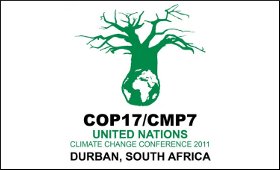|

|
Durban climate talks: What it means for India?
|
|

|
|
| Top Stories |
 |
|
|
|
IANS | 16 Dec, 2011
At the recently concluded UN climate change talks in Durban, the world agreed to a new global climate change regime by 2020 to bring down emissions to save the planet. But cutting carbon emissions will be a tough task for India in the years to come as the country needs to balance its development trajectory with transition to a low carbon economy.
Transition to a low carbon economy means huge investment in clean technology, switching from coal and oil to low-carbon fuels for power generation and transport. And the most important part of this low carbon growth will need changes in behaviour and lifestyle of the people.
Manufacturers and retailers will also play an important role in selectively editing out products that lead to more carbon footprint while promoting energy efficient and energy conservation products to consumers.
India has to look for new ways to cut emissions and pay big-time for these. The transition to green energy calls for investing big-time in solar, biomass or off-shore wind energy but despite that India will still not be able to substantially reduce dependence on coal.
"India really needs to focus on how it will meet the power demand post 2020. It is a warning bell to start looking of low carbon power sources that reduce dependence on coal and oil," a senior environment ministry official told IANS.
"We know protests over nuclear energy and we cannot meet the power demand by only harnessing solar, wind and hydel energy. This means we will face acute power shortage in years to come," he said.
The big question emerging out of the Durban outcome is whether India is rich enough to pay for the cost of transition to a low-carbon economy? A section of policy makers say yes, but facts and figures paint a totally different picture.
The Centre for Science and Environment (CSE) recently did an analysis of six of the most energy and emission-intensive sectors of Indian industry. These high-growth sectors -- power, steel, aluminium, cement, paper and fertilizers -- add up to 60 percent of
India's carbon dioxide emissions currently.
Contrary to general perception, the study finds many of these sectors -- the companies that comprise them -- operate at global best levels so far as energy efficiency and greenhouse gas emissions are concerned.
"Even the much-abused coal-based power generation sector fares well in its emissions record. Indeed, industry has invested in the best technologies because in India energy costs are high. Of course, more can be done to improve performance," CSE deputy director general Chandra Bhushan told IANS.
He says that India is not the place the world can look to for easy and cheap emission reduction in the future.
"The fact is in all high-polluting sectors, technology options to reduce emissions stagnate after 2020. There is no real way India can reduce emissions without impacting growth, once it crosses the current emission-efficiency technology threshold," he added.
India with a population of 1.2 billion and over 40 percent of them living under poverty line has to provide affordable power to massive numbers of people. The bottom line: the going is tough for India post Durban.
Durban talks: India's gains and losses
The UN climate change talks in Durban arrived at a four-pronged Durban Package to save the planet by controlling emission of greenhouse gases. The gains and losses for developing countries like India:
Gains
* Principle of equity: Every person in the world should have an equal carbon space in the atmosphere.
* Gets nine years of economic growth without any emission cuts.
* Principle of common but differentiated responsibility: Recognising that developed countries are principally responsible for the current high levels of greenhouse gas emissions in the atmosphere as a result of more than 150 years of industrial activity; hence, there is a heavier burden on developed nations to cut emission.
Losses
Durban package doesn't mention:
* Technology Transfer: Developing countries like India have been demanding that rich countries provide them technologies that are more energy efficient and help them in reducing emissions. The intellectual property rights issues are a bone of contention as rich countries do not want to do away with the IPRs.
* Unilateral Trade Measures: India had objected to countries levying taxes like aviation tax by the European Union that will come into effect from 2012 in the name of cutting emissions.
|
|
|
| |
|
|
|
|
|
|
|
|
|
|
|
|
|
|
| |
| Customs Exchange Rates |
| Currency |
Import |
Export |
US Dollar
|
66.20
|
64.50 |
UK Pound
|
87.50
|
84.65 |
Euro
|
78.25
|
75.65 |
| Japanese
Yen |
58.85 |
56.85 |
| As on 13 Aug, 2022 |
|
|
| Daily Poll |
 |
 |
| PM Modi's recent US visit to redefine India-US bilateral relations |
|
|
|
|
|
| Commented Stories |
 |
|
|
|
|
|
| |
|